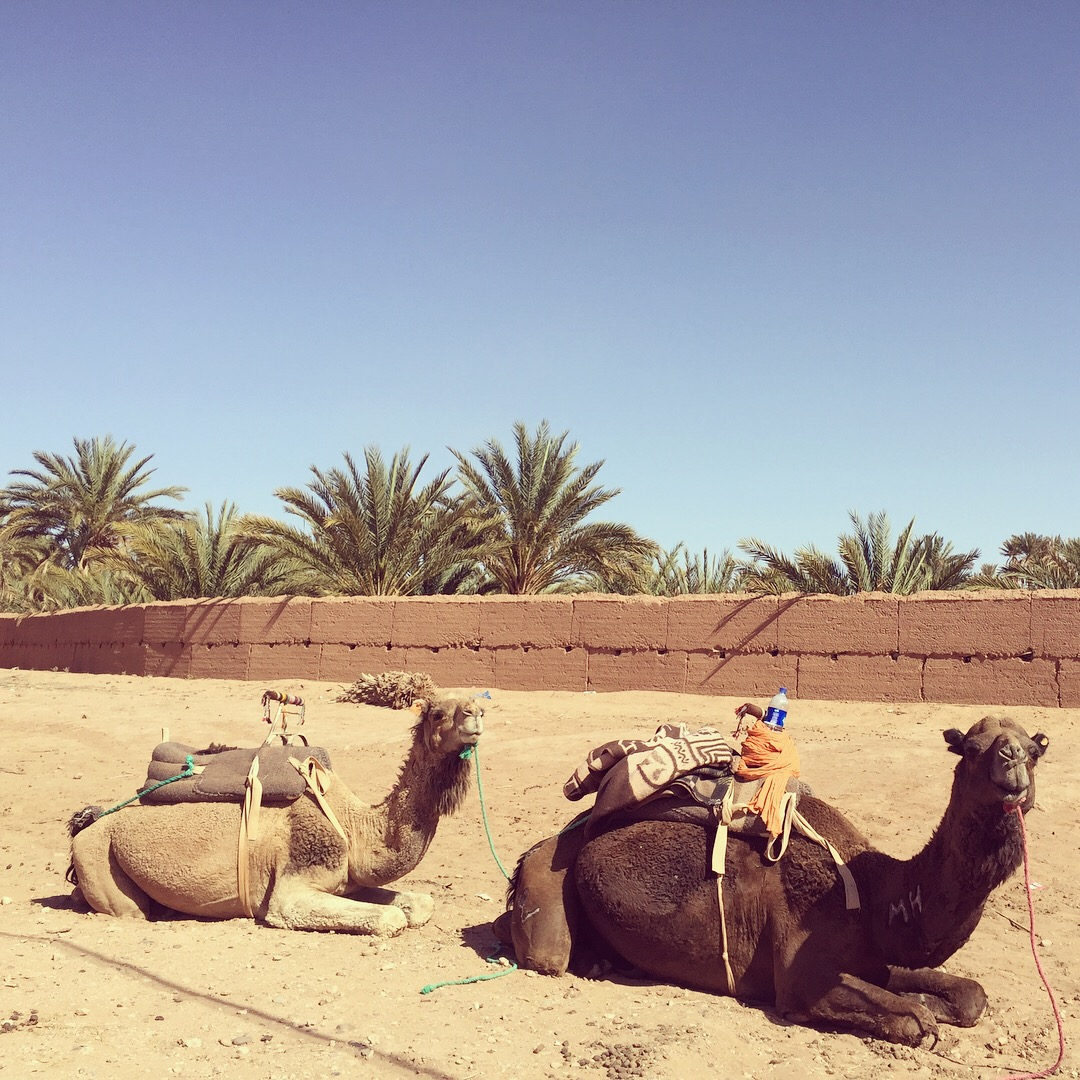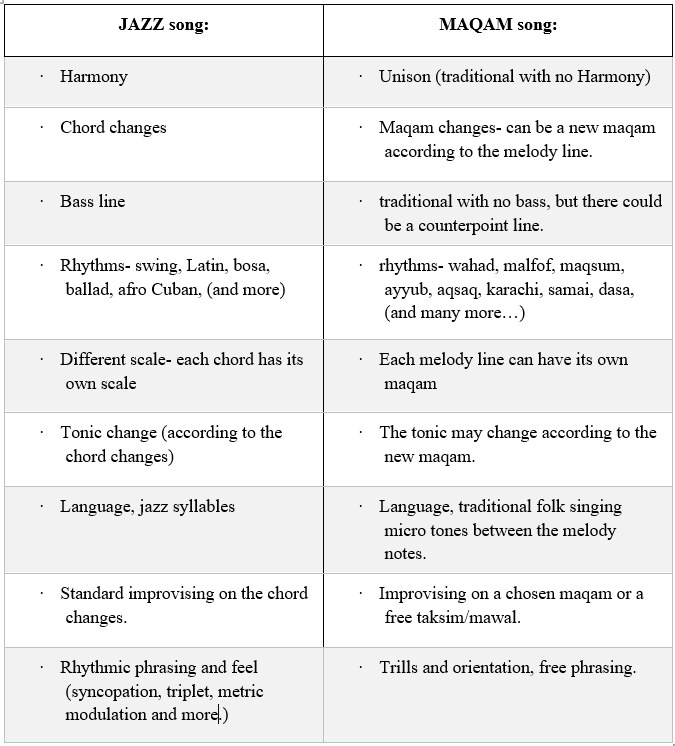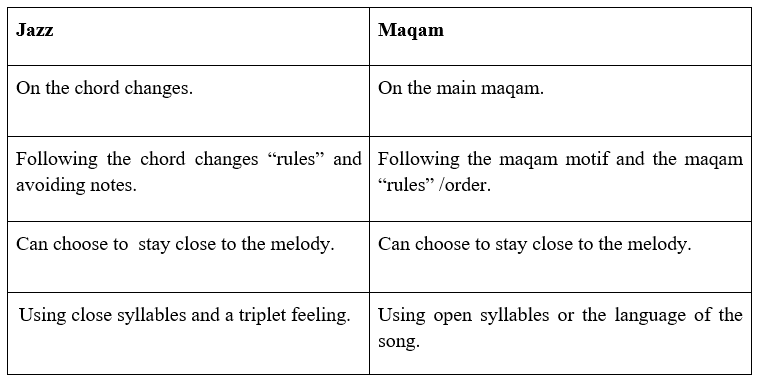As we can see from the table, the two genres are different in most areas. But what are the shared points where the genres connect? The places that are shared and can be influenced by each other? The places where I can relate while I’m singing and improvising?
Vocal jazz and maqam Meeting Point:
· Hybrid – mixing the two styles
· Improvisation – space to create and connect
· Find the shared scale- for example, Hijaz can be interpreted to minor harmony scale(v7b9b13)
· Language- different syllables when improvising
· Using different Colour in the voice when singing/ or different orientations on your instrument.
· Feel the vibe of the song, the meaning and the connection and express it with your voice.
· Rhythmical- connect with melody rhythm idea.
8.3 Examples
8.3.1 Example I: Jazz standard Caravan
To exemplify finding shared points we will look at the jazz standard- “Caravan” by Juan Tizol and Duke Ellington. The first time I heard this song, I immediately realized that it's different from other jazz standards in the areas of the rhythm, feel and tension and I could feel that Duke Ellington and Tizol were influenced by Arabic music in this composition.
I later reflected and analyzed the way I approach different songs as a vocalist. This helped me understand how to arrange my compositions, taking into account my focus points and the shared and meeting points of the two genres. I realized that if I am able to form this hybrid through singing, then this will guide me to obtain the sound I desire in my compositions and arrangements.
8.3.2 Example II: A traditional Arabic song Lamma Bada
Here is an example of the shared point, using an Arabic folk song Lamma Bada Yatathanna لما بدا يتثنى, and adding the harmony from the jazz world. The traditional song arrangement is in unison with no harmony. It’s one of the oldest Arabic folk songs on samai 10/8 rhythm.
Samai originally came from the Ottoman empire, influenced by the Arab world and music and is usually in the form of a long classical composition in 10/8 form with each part having a different maqam. The fourth part is usually in a different meter, and then goes back to the taslim (The chorus on 10/8).
‘Lama bada’ is on Maqam Nahawand, a shortened samai form containing only the A and B parts. The song has been translated into numerous languages and hundreds of versions have been recorded by artists around the world.
The melody is strongly connected to the rhythmic pattern. 1,4,678,10. D- -T-DDT-T
8.3.3 Example III: Original Composition Binti
The third example I would like to share is an original composition I composed on the Oud. While composing I considered the motifs of the maqam and phrasing, I added chords that go with the maqam and created a new jazzy scale. I arranged this composition for the jazz Big Band in Aarhus Denmark and later orchestrated it for my music ensemble “Beyond the river” project in Helsinki. The song is entitled- “Binti”. Binti in Arabic means my daughter, the lyrics are about a mother/father telling their daughter that she has power and it's her choice how to use it in her life. to love, to grow, to be happy. The song is written in 7/8 meter on the Hijaz and Nakriz maqam.
The big band arrangement sound makes the song become much more jazzy, and the different harmony voicing, the maqam and time signature 7/8, the Arabic and Hebrew lyrics make the song Arabic music.
On the solo part I chose to put the chords on the back so the musicians would feel comfortable with their solos over the chords and not maqam. I tried in the composition and the arrangement to use both of the genres and to treat them as one unity.
Of course, with Arabic musicians or with a smaller jazz group it would have sounded different than with a big band or a bigger band where there are many musicians and the diversity of background of the musicians also influence the sound. (I will expand on this subject in chapter 10 and on chapter 9.5 I will compare the tow different ensemble playing Binti song. )
8.4 The Shared Point
Jazz and Arabic styles can’t be interned by just reading the music. A reason for this is that both styles allow a certain amount of freedom of expression for the musicians. You need to hear and feel the music over a period of time and be exposed to different styles and variations to intern both styles. When you perform in these styles you need to be familiar with the music and be prepared and most important, listen to your fellow musicians.
The shared point of the two music styles is the creation of a new style of music. In order to play this hybrid music, the musicians need to be open minded to the new possibilities of creating new music using both their knowledge of jazz, the world of improvisation and Arabic music - the maqamat system.
There are many bands and musicians today who mix jazz and Arab music styles, and probably there will be many more in the years to come. But in the literature, there is a paucity of material and research on this specific style and pedagogical approaches.
8. When jazz and maqamat meet
In this chapter we will look at the shared points from the point of view of a vocalist, improviser, composer and arranger. As a singer, when I play or practice a traditional and classical jazz standard the first thing that I do is to learn the melody, the lyrics, and the meaning of the song. The next stage is to connect the melody with the harmony, to play the chords and the bass line. In jazz I feel that the chords give the colours to the melody and I like to feel this connection and express it in my phrasing or improvisation. I improvise on the chord changes while knowing and practicing the scale of each chord and noticing the key changes, the bass line and the rhythm, beats and feeling of the song.
Below is my list of the factors which in my opinion together form a jazz song:
JAZZ song:
• Harmony
• Chords changes
• Bass line
• Rhythm- swing, Latin, bosa, ballad etc..
• Rhythmic phrasing and feel (syncopation, triplet, metric modulation and more..)
• different scales- each chord has its own scale
• Tonic change (according to the chords changes)
• Language, Jazz syllables
• Standard improvising on the chord’s changes.
When I encounter an Arabic song, I won’t search for the harmony or a bass line, I will first learn the melody, and find the maqam/scale inside the melody line. Then I turn to the lyrics, the question and answer lines, and then the rhythmical pattern which sometimes connect and support the melody but other times doesn't. So my system is to first concentrate on the melody and then connect it to the rhythmical pattern, and clap it to see if there are polyrhythmic parts. I listen for the colour of the song, the changes of the maqams and the feeling of the melody, and can then improvise in this space with trills and my own orientation.
To the lest is the song partitura for the “beyond the river project” for an ensemble of 14 musicians: voice, piano, oud, guitar, 2 cello, violin, percussion, accordion, soprano saxophone, trumpet, clarinet, tenor saxophone/flute, bass, drums.
This is the composition and the arrangement. When I wrote this song I had no idea who the musicians would ultimately be. However, when I wrote the arrangements and orchestration I wrote knowing who the group of musicians would be. I first arranged for the Big Band in Aarhus, so I made the arrangement to blend with the horns sections and harmony parts, I made my solo part as a written solo which would be played by the entire big band together -similar to a soli technique for the style of a big band. It was a challenge to find the right leading voicing technique and harmony for this part, because it's on the hijazz maqam and I didn’t want to lose the colour of the maqam by adding too many tension notes. I required a new different voice leading technique so I followed my intuition and my ears. Here I would like to thank Jens Christian Jensen (my teacher at the Royal Music Academy in Aarhus ) who helped me find the right voicing.
Sometimes to “spice up” the sound, in order to achieve the Arabic sound effect from the horns section when answering the melody line, I used the quarta gaps for voicing. When I rearranged and orchestrated this song for a different project, I needed to adapt the orchestration to the different instruments and musicians. I kept the big band arrangements and voicing, and considered the colour and the new blends of the instruments and registers.
Here is a link to hear the song “Binti” from the live performance “Beyond the River” concert in Helsinki 12/12/2019 . Mix by Shlomi Gvili Haogen studio Israel.
8.1 Comparing Jazz and Maqam songs
The following table describes the differences between a jazz song and a maqam song:
There are many differences between the way a jazz and Arabic song is built. Each style approaches improvisation in a different way. Improvising is actually composing on the stage, composing a new melody that relates to the song, adding your point of view and colour. It’s usually the place for the player to shine and be heard. It's an opportunity for the musician to show his personal skills and his interpretation of the song.
I have noticed when I practice and improvise that I have a different mindset when I work on different styles. For example, when I improvise over a jazz standard I think of the jazz style and technique, making sure I following the chords and use jazz scat syllables, and when I improvise on an Arabic song, I focus on one maqam, sometimes changing to another related maqam, but keeping the same colour and adding micro tones and orientation, decorating the melody and using my eastern voice and languages.
The main points I have noticed are summarized in the table below:
8.2 Comparing Jazz and Maqam vocal improvisation
As you can see in the music chart, the chords are open and minimized at the A part and at the B part they move in quarta with chromatic moves inbetween. There are motives from the Arabic world.
The song key is in F minor. Hijaz maqam works very well on the A part as Hijaz from C. (on bar 8 its hijaz kar with the major 7 and bar 12 is lami or chromatic down notes).
It is interesting that the scale C7(b9b13) harmonic minor scale is actually the same notes as the Hijaz maqam.
Here is a link to hear the song “Caravan” with eastern influence and Latin style arrangement from my album “Earth Colour” 2016. This album was recorded in Dublin with jazz musicians from different cultural backgrounds, and you can hear the influence that each musician adds.
Piano- Leopoldo Osio, Drums- Cote Calmet, Contrabass- Marco Santaroni, Vocal and arrangement- Michal Hoter Recording- Camden Studio Dublin Mix- Live room studio Tel Aviv Oren Eitan
During the improvisation you can hear tha the b9, from the C7(b9b13) chord and the colour of the eastern voices using the maqam Hijaz colour.
In my arrangement I wrote the same percussion rhythmic pattern for the bass and the chords fall on the same beat. There is no set way to arrange and harmonize an Arabic song, I just sat on the piano and wrote the chords that work for my ears, trying to support the melody as much as I could, and make a small interesting counterpoint with the bass line.
In the first bars the bass holds the 1st and 4th notes of the maqam and slowly joins the harmony and plays the root of the chord.
Here is my arrangement from the album “Kol Kollee” (that should be released in 2021). to the song “lama bada” In this recording you can hear the Arabic music instruments playing, and the only elements from jazz is the harmony and the second voicing.
Oud- Yair Dalal, Piano- Orel Oshrat, percussions- Erez Mounk, contrabass- Hagai Bilitzky, Nai- Moran Kaner, kanun- Sarel Hacohen, Clleo- Hilla Epstein, Violin- Elad Levi, Voices- the Hoter family, Music arrangement and producing- Michal Hoter. Recorded and Mix by- Shlomi Gvili at HaOgen Studio Israel.



